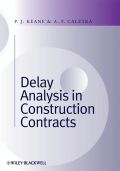
INDICE: CHAPTER 1: INTRODUCTION.1.1 General.1.1.1 Purpose of Delay Analysisin Construction.1.1.2 Guidance.1.1.3 Construction Planning and programming.1.2 Construction Delays.1.2.1 Identifying delays.1.2.2 Analysing Construction Delays.1.2.3 Delay claim life-cycle.1.3 Burning Issues in delay analysis.1.4 Presentation and Case Study.CHAPTER 2: CONSTRUCTION PROGRAMMES.2.1 Introduction Planning, Programming and Project Controls.2.1.1 Elements of a successful project.2.2 Planning and Programming.2.2.1 Project Planning.2.2.2 Work Breakdown Structure.2.3 CPM Programming Techniques; the Fundamentals.2.3.1 Activity Durations.2.3.2 Activity Relationships.2.3.3 Event Date Calculations.2.3.4 Forward Pass.2.3.5 Backwards Pass.2.3.6 Constraints.2.4 Baseline Validation.2.4.1 The project baseline.2.5 Other Planning Techniques.2.5.1 PERT Project Evaluation and Review Technique.2.5.2 Gantt Charts (Bar Charts).2.5.3 Line of Balance.2.5.4Critical Chain Method/Theory of Constraints.2.6 Why use CPM Planning or Scheduling Techniques?.2.6.1 Project Management.2.6.2 As-planned programmes.2.7 Project Controls and the Project Control Cycle.2.7.1 Progress Monitoring.2.7.2 Process and Analyse Information, Earned Value Method.2.7.3 The Cost and SchedulePerformance Curves.2.7.4 Time Control.2.7.5 Programme Updates.2.8 Records, Records, Records.2.8.1 Electronic Records.2.9 Predatory Programming Practices.2.10 Guidance.CHAPTER 3: IDENTIFICATION OF CONSTRUCTION DELAYS.3.1 Establishing a Basis for Identifying Delay.3.1.1 General Requirements.3.2 Factual Evidence and As-Built Programmes.3.2.1 As-Built Programme Preparation.3.2.2 Summary.3.3Identification of Delay Events.3.3.1 Delay identification.3.3.2 Recording delays.3.4 Identification and Analysis of Disruption.3.4.1 Establishing Cause.3.4.2 Total Cost Claims/Global Claims.3.4.3 Measured Mile.3.4.4 Graphical Presentation.3.4.5 Summary.CHAPTER 4: ANALYSIS OF CONSTRUCTION DELAYS.4.1 Introduction to Delay Analysis Techniques.4.1.1 The use of CPM techniques.4.1.2 Project Planning Software.4.1.3 Identifying Delays Cause or Effect?.4.2 Explanation of the available techniques.4.1.4 Additive Methods of Delay Analysis.4.1.5 Impacted As-Planned.4.1.6 Time Impact Analysis.4.1.7 Collapsed As-Built.4.1.8 As-Built Based Methods of Analysis.4.1.9 Total Time Assessments.4.1.10 As-Planned VsAs-Built Windows Analysis.4.1.11 Contemporaneous Windows Analysis.4.1.12 Month-to-Month Update Analysis.4.3 Selection Criteria and Guidance.4.1.13 The SCL Delay and Disruption Protocol.4.1.14 The core statements of principle.4.1.15 Recommended Practice No. 29R-03 Forensic Schedule Analysis.4.1.16 Which technique to use under given circumstances.4.1.17 Summary.CHAPTER 5: PROBLEMATIC ISSUES.5.1 Introduction.5.2 Float and Delay Claims.5.2.1 General Definitions - What is Float?.5.2.2 How Float is used.5.2.3 Float Loss and the Impact.5.2.4 Measurement of Float Loss.5.2.5 Who Owns the Float?.5.3 Concurrency.5.3.1 Definitions.5.3.2 Delay Analysis and Concurrency.5.3.3 SCL Delay and Disruption Protocol.5.3.4 Delay Scenarios.5.3.5 Common Questions.5.3.6 Experience and Commonsense.5.3.7 The Concept of Pacing.5.4 Programme Approvals and Onerous Specifications.5.4.1 Programme Requirements, Format and Compliance.5.4.2 Approval or Acceptance of Construction Programme.5.5 Acceleration and Mitigation.5.5.1 Mitigation.5.5.2 Acceleration.5.5.3 Contractors right to early completion.CHAPTER 6: EFFECTIVE PRESENTATION OF DELAY ANALYSIS.6.1 Introduction.6.2 Case Study Airport Terminal Expansion.6.2.1 Initial analysis by party appointed planning experts.6.2.2 Using Time Impact Analysis for Prolongation.6.2.3 Tribunal Planning Experts Contemporaneous Approach.6.2.4 Runway Extension -Are delays to the Runway Extension relevant?.6.2.5 Terminal Building.6.3 Float Mapping - Approach and Methodology.6.3.1 Extracting Float Values.6.3.2 Create Float Map.6.3.3 Identify Driving Activities.6.3.4 As-Built Critical Path.6.4 Demonstrating Acceleration.6.5 Presentation Skills Demonstrative Evidence.6.5.1 Summary
- ISBN: 978-1-4051-5654-7
- Editorial: Blackwell
- Encuadernacion: Cartoné
- Páginas: 272
- Fecha Publicación: 01/08/2008
- Nº Volúmenes: 1
- Idioma: Inglés
